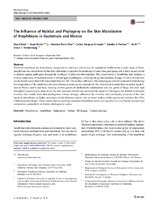Mostrar el registro sencillo del ítem
The influence of habitat and phylogeny on the skin microbiome of amphibians in Guatemala and Mexico
| dc.creator | Ellison, Silas | |
| dc.creator | Rovito, Sean | |
| dc.creator | Parra-Olea, Gabriela | |
| dc.creator | Vasquez-Almazán, Carlos | |
| dc.creator | Flechas Hernández, Sandra Victoria | |
| dc.creator | Bi, Ke | |
| dc.creator | Vredenburg, Vance T. | |
| dc.date.accessioned | 2018-12-05T16:40:54Z | |
| dc.date.available | 2018-12-05T16:40:54Z | |
| dc.date.issued | 2018-11-22 | |
| dc.identifier.issn | 0095-3628 | spa |
| dc.identifier.uri | https://link.springer.com/article/10.1007%2Fs00248-018-1288-8 | spa |
| dc.identifier.uri | http://hdl.handle.net/20.500.11761/35150 | |
| dc.description.abstract | Microbial symbionts are increasingly recognized as playing a critical role in organismal health across a wide range of hosts. Amphibians are unique hosts in that their skin helps to regulate the exchange of water, ions, and gases, and it plays an active role in defense against pathogens through the synthesis of anti-microbial peptides. The microbiome of amphibian skin includes a diverse community of bacteria known to defend against pathogens, including the global pandemic lineage of Batrachochytrium dendrobatidis associated with mass amphibian die-offs. The relative influence of host phylogeny and environment in determining the composition of the amphibian skin microbiome remains poorly understood. We collected skin swabs from montane amphibians in Mexico and Guatemala, focusing on two genera of plethodontid salamanders and one genus of frogs. We used high throughput sequencing to characterize the skin bacterial microbiome and tested the impact of phylogeny and habitat on bacterial diversity. Our results show that phylogenetic history strongly influences the diversity and community structure of the total bacterial microbiome at higher taxonomic levels (between orders), but on lower scales (within genera and species), the effect of habitat predominates. These results add to a growing consensus that habitat exerts a strong effect on microbiome structure and composition, particularly at shallow phylogenetic scales. | spa |
| dc.format | application/pdf | spa |
| dc.format.extent | 1-11 p. | spa |
| dc.language.iso | spa | spa |
| dc.publisher | Springer | spa |
| dc.relation.ispartofseries | Año 2018 | spa |
| dc.source | reponame: Repositorio Institucional de Documentación Científica Humboldt | spa |
| dc.source | instname: Instituto de Investigación de Recursos Biológicos Alexander von Humboldt | spa |
| dc.subject | Microbioma | spa |
| dc.subject | Anfibios | spa |
| dc.subject | Salamandra | spa |
| dc.subject | Habitat | spa |
| dc.subject | Filogenia | spa |
| dc.subject | Amériica Central | spa |
| dc.title | The influence of habitat and phylogeny on the skin microbiome of amphibians in Guatemala and Mexico | spa |
| dc.type | info:eu-repo/semantics/article | spa |
| dc.type.spa | Artículo | spa |
| dc.identifier.doi | https://doi.org/10.1007/s00248-018-1288-8 | spa |
| dc.publisher.edition | Regular | spa |
| dc.subject.subjectenglish | Microbiome | spa |
| dc.subject.subjectenglish | Amphibian | spa |
| dc.subject.subjectenglish | Salamander | spa |
| dc.subject.subjectenglish | Habitat | spa |
| dc.subject.subjectenglish | Phylogeny | spa |
| dc.subject.subjectenglish | Central America | spa |
| dc.publisher.journal | Microbial Ecology | spa |



